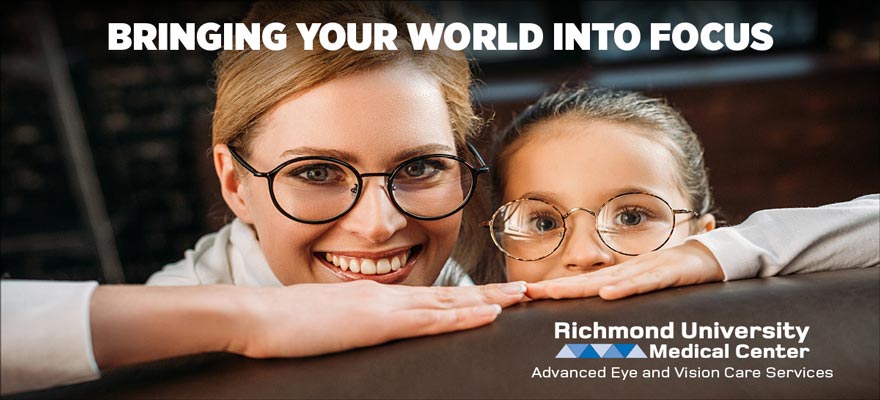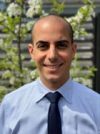

By David Mostafavi, M.D.
Chief of Ophthalmology at RUMC
Richmond University Medical Center
March is “Save Your Vision” month, which makes it a perfect time to talk about how we can protect our eyes. After all, they are the window to our soul and the lens to our world—and we should be doing everything we can do to preserve them. From birth through adulthood, vision is never something we can take for granted. That is why we spoke to Dr. David Mostafavi, Chair of Ophthalmology at Staten Island’s Richmond University Medical Center (RUMC), about tips for optimum eye health and what to expect as we age.
Vision Health in Babies and Kids
Unfortunately, babies cannot articulate vision issues and little kids are only partially reliable when it comes to reporting eye problems. That is why ophthalmologists at RUMC usually rely on a pediatrician or a parent to give them a heads-up if something does not seem right. As Dr. Mostafavi said, “parents are usually the first people to notice: ‘Hey, my kid’s not really focusing very well,’ or, ‘the eye is out sometimes’ or ‘the eye is in.’”
The most common early sight disorder for kids is amblyopia, in which the brain favors one eye over the other. “When you’re born, your two eyes are competing for real estate in your brain,” Dr. Mostafavi explained. “When one eye sees better than the other, the brain just says, ‘I’m going to give more brain cells to the other eye because this eye is kind of wasting my time here.’”
It is important that amblyopia is caught early, ideally before a child turns seven or eight. “If one eye is seeing better than the other eye, and if it’s not corrected at a young age, then the brain has already settled. It’s already divvied up the cells between the two eyes,” Dr. Mostafavi explained. Once diagnosed, ophthalmologists at RUMC can use a patch or eye drops to cover or weaken the good eye until the other one catches up with it. Surgery can also correct the problem. “We tighten or loosen the muscles of the eye to straighten the eyes out and make the eye function better—so the brain can recognize it,” Dr. Mostafavi said.
Whether it is amblyopia or simply a refractive problem—in which case your child needs glasses, Dr. Mostafavi urges parents to err on the side of safety and make an appointment at RUMC. “We’d rather have parents be overly cautious than not—because worst-case scenario, they come in and say, ‘oh, everything’s fine—as opposed to not doing that.”
When kids are old enough, the heads-up usually comes from either their pediatrician’s office or school. (Some preschools and all public schools in New York City offer an annual eye exam beginning in first grade.) “We get a lot of consults from the school where the kid has no complaints, zero complaints, but failed the vision test at school,” Dr. Mostafavi said.
Vision Health in Teenagers
Although everyone seems to be online more than ever these days, teenagers often have the most prolonged screen-time—which can be a problem for their eyes. “A teenager who’s looking at a computer screen for 8-10 hours a day—the muscles in his eyes are constantly in a state of accommodation or contraction whether they realize it or not. Those muscles get pretty worn out and tired,” Dr. Mostafavi said.
While heavy computer use is not linked to permanent eye damage, hours of screen time can result in short-term eyestrain and loss of focus—and could be a risk factor for myopia, according to Dr. Mostafavi.
He recommends teenagers take frequent breaks from the screen, even if that just means closing their eyes or looking in the distance. “That will actually relax the muscles and give them a little bit of a quick break. Then they can go back to whatever they’re doing up close.” Many experts recommend the 20/20/20 rule: Every 20 minutes, focus on something besides your device for 20 seconds, 20 feet into the distance.
The majority of vision problems at this age are anatomical or genetic—so there is not much a teen can do to cause or prevent them. (Conditions like glaucoma and cataracts don’t usually occur at this age.) Parents should be on the lookout for squinting, but if a teen is not seeing well, their school (or even a driver’s license test) will often flag it. In fact, Dr. Mostafavi says schools in New York tend to be overly cautious. “They over-call things, which is good. That’s what you want.”
Glasses or contact lenses can usually solve the issue, but teens are rarely good candidates for LASIK or laser surgery. “We like to say that if there’s really no refractive change within a three-to-four-year period, and the eye is stabilized in terms of its prescription, then we can offer someone LASIK,” Dr. Mostafavi said. “At least 18 years old, but ideally 21 years old is the threshold.”
Vision Health in Adults and Seniors
In general, adults should eat well, not smoke and avoid excessive UV light to help prevent an ocular condition called macular degeneration, which is one of the leading causes of vision loss in seniors. Adults between the ages of 20 and 40 should be checked by an ophthalmologist, preferably every 5 to 10 years—even if they have no issues or pain.
According to Dr. Mostafavi, 40 is the magic age—when most adults start needing glasses and should have a comprehensive eye exam every two to four years. This is when presbyopia, a weakening of the eye muscles, develops and causes blurry vision at near distances. “This phenomenon can literally happen overnight and be distressing to people; however, it’s a normal part of aging,” Dr. Mostafavi says.
“Around age 55 is when adults should really be more vigilant about eye exams and should be seen every one to three years,” Dr. Mostafavi said because there is a greater risk for cataracts, glaucoma, age-related macular degeneration (AMD), and diabetic retinopathy. According to the National Eye Institute, more than 37 million people aged 40 and older have these ailments.
Family history plays a big role in these diseases, as does race. Latinos and African Americans are much more likely to end up with glaucoma and diabetic retinopathy. Caucasians are at greater risk for AMD. When it comes to cataracts, more than half of adults develop the condition by the time they hit 80. Cataracts, which cloud the vision and are the top cause of blindness worldwide, can be corrected with surgery, but they’re not preventable. “Cataract surgery is a very common procedure. We do a lot of them here at RUMC,” Dr. Mostafavi said.
Seniors should see their eye doctor every one-to-two years, Dr. Mostafavi says—even though “it’s not a hard-and-fast rule.” Another important reason to get frequent eye exams as an older adult: Your eyes can be a clue to other health problems— such as diabetes and high blood pressure. “It’s the only place in the body, believe it or not, that we can actually see blood vessels in real-time,” he says.
While the eyes are truly amazing, we cannot predict how well they will hold up during our lifetimes. And unfortunately, eating a lot of carrots is not the key to perfect vision. Instead, knowing what to look for at every age, taking care of our bodies, and getting frequent checkups by expert ophthalmologists—like those at RUMC—can go a long way towards protecting and preserving our eyes.
To make an eye exam appointment with RUMC’s department of ophthalmology, call 718-818-4848 and find out more about their advanced vision and eye care services at www.rumcsi.org/opthalmology.

